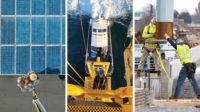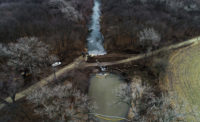Even as uncertainty clouds the future of liquefied natural gas (LNG) projects across the world, construction on the estimated $31-billion LNG Canada project in British Columbia is moving ahead.
The biggest private-sector investment in Canada history, in its third year of construction, LNG Canada has faced COVID-19 delays and cost overruns.
Project joint venture contractors Fluor Corp. and JGC Corp., plus subcontractor Soletanche Bachy Canada, this spring finished phase one of work on its estimated $18-billion export terminal in Kitimat, B.C., the major component of the project located 405 miles north of Vancouver.
LNG Canada is a joint venture of Royal Dutch Shell plc, Petronas, Mitsubishi Corp., PetroChina Canada Ltd. and Korea Gas Co. and local units.
Also part of the project is the estimated $5-billion, 670-km Coastal GasLink pipeline being built by TC Energy to transport gas from northern B.C. fields to the terminal. Other LNG Canada costs include investments in upstream natural gas infrastructure.
In sharing recent quarter results, firm executives expected continuing impacts to cost and schedule from the virus, scope changes and permit delays. "We remain on track to reach first cargo in mid-decade," says a project spokesman.
Delivered in June to the project’s new offloading port in Kitimat Harbour were a 345-tonne, 50-m-tall cryogenic heat exchanger and two slightly smaller units that will convert gas to liquid for export. Crews last month moved the equipment 3 km to the main site on self-propelled modular vehicles, said LNG Canada.
CEO Peter Zebedee termed the delivery a “significant milestone.” With construction set to begin its peak next year, work could require up to 7,500 workers in rotating shifts.
In a June 23 investor note on Fluor, Jamie Cook, Credit Suisse lead construction sector research analyst, said the project is “fully staffed” as the pandemic wanes, with the contractor not anticipating balance sheet charges related to its fixed-price contract. She said engineering and procurement completion “is significant” because it “de-risks” Fluor from commodity price inflation and rework.
Market Headwinds Seen
As work progresses, LNG faces shifting investor enthusiasm and market demand, as well as low-cost competition from Russia and Qatar.
Australia’s Woodside Petroleum Ltd. and Chevron Canada Ltd. recently pulled back LNG Canada financial support. A 2020 Global Energy Monitor report listed 13 cancelled Canadian LNG projects.
Pieridae Energy Ltd. CEO Alfred Sorensen said In a July 2 statement, that as of June 30, "despite strong project fundamentals" for the Calgary-based firm's planned $8.1-billion Goldboro LNG export terminal in Nova Scotia and efforts to advance it, the developer has "not been able to meet all of the key conditions necessary to make a final investment decision."
The project was set to import Alberta natural gas for shipment to Germany, and Sorensen noted strong LNG demand in Europe and high global prices. Pieridae had signed an agreement with Bechtel last year for fixed-price engineering, procurement, construction and commissioning services.
Sorensen said "it became apparent that cost pressures and time constraints due to COVID-19 have made building the current version of the LNG Project impractical." He said the firm "will now assess options and analyze strategic alternatives that could make an LNG Project more compatible with the current environment."
But a recent Canada Energy Research Institute report said energy demand rises with economic recovery, and nuclear and renewable power cannot support that alone.
“LNG is one piece of the energy system that will be required to achieve global climate-change goals,” said LNG Canada in a statement last month.






